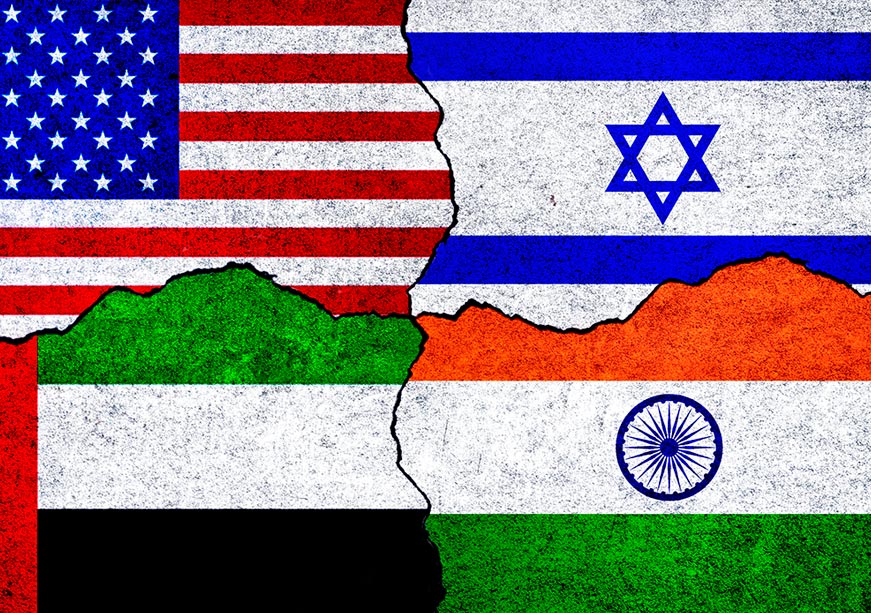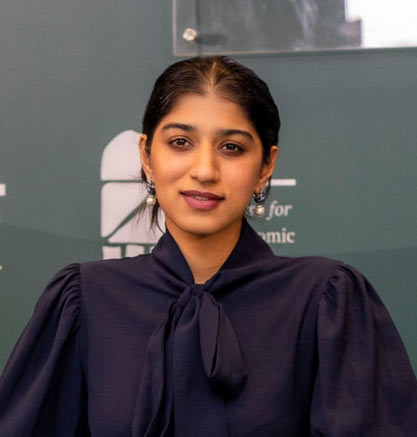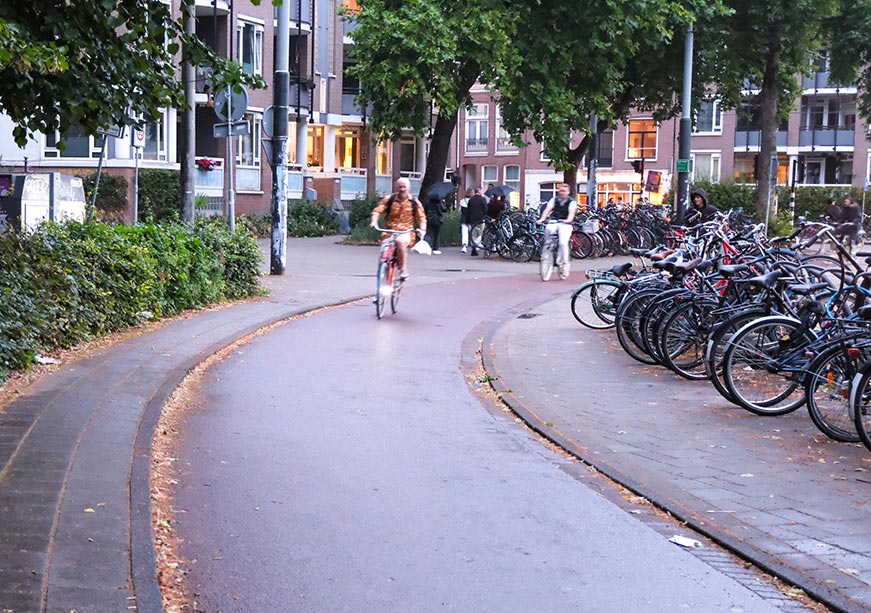From tariff wars and strategic decoupling to climate-induced catastrophes and regional conflicts, geopolitical whirlwinds have significantly fragmented the global order. In an increasingly multipolar world where volatility is the norm and short-term optics trump long-term rational policymaking, we cannot afford to let the European Union’s green transition agenda become collateral damage.
Shock-resilient frameworks that insulate climate cooperation from geopolitical volatility and economic disruption are the need of the hour. At this strategic inflection point, the ‘I2U2’ groupcomprising the United States (US), India, the United Arab Emirates (UAE), and Israel—emerges as a flexible and high-impact vehicle. As minilateralism gathers momentum, I2U2, recently reinvigorated by the February 2025 meeting between the Indian Prime Minister Modi and US President Donald Trump, offers an agile format for advancing climate-driven cooperation, fostering economic stabilisation, and deepening regional integration.
Economic Disruptions and Political Fault Lines
The resurgence of protectionism, amplified by the Trump presidency, shook governments, stock markets, and people alike. Tariffs have rattled global supply chains and inflated consumer costs. Today’s inward-turning economic policies, pursued in the name of national security and resilience, pose a direct threat to green value chains, which are inherently global. This is particularly concerning for the green economy, whose value chain is global by default and extensively dependent on cross-border flows of vital green transition components, for example— solar panels, Electric Vehicle (EV) batteries, rare earth, and other critical minerals. It must be noted that it is not easy to develop domestic capacity and ‘reshore’ overnight must be heeded. Besides, any meaningful action can be easily reversed with changes in government, sending investors and long-term policy planning into a tailspin.
Historically, energy security has been a significant driver of geopolitical fragmentation. The US strategic disengagement from the Middle East coincided with its own shale oil revolution. The Houthi attacks on the Red Sea have, in turn, catalysed interest in alternative connectivity corridors. Initiatives such as the India-Middle East-Europe Economic Corridor (IMEC) are gaining traction as logistics solutions and regional and climate-related stabilisers.
If the climate agenda remains vulnerable to geopolitical tensions and economic shocks, the energy transition risks losing momentum. A strengthened I2U2, strategically aligned with IMEC, can mitigate this risk by anchoring climate action in practical, cross-regional cooperation that enhances both resilience and stability.
I2U2: A Minilateral Made for the Moment
Minilaterals offer a distinct platform to collaborate among like-minded countries. They are flexible, targeted, function-driven, and can be particularly effective in reconciling strained bilateral relations or paralysed multilateral institutions. In some sense, they amplify Ricardo’s principle of comparative advantage to international cooperation. For instance, the US with its strong capital market and innovation, the UAE with its deep hydrocarbon revenues and strategic geography, India with its labour, scale, and market, and Israel with its cutting edge technology and its strategic location as the conduit between the East and the West offer a complementarity that can marry economic prosperity with environmental protection.
Each of the I2U2 countries has expressed an interest in cooperating, but the volatile political climate has stalled progress. A green transition agenda rooted in economic pragmatism can provide both the momentum for action and a foundation for long-term regional stability. Energy Security is clearly an equally shared concern for both the Global North and the Global South today. Thus, their coordinating efforts to strengthen and diversify green supply chains could drive prosperity while advancing global climate goals.
The logic is rather simple: small groups, big agendas, and targeted action. The I2U2— anchored by four influential and diverse power centres— can add significant weight to the green transition agenda. It has the potential to catalyse green manufacturing and job creation, expand access to new markets, deepen strategic partnerships, and build resilient, diversified supply chains. By pooling resources and focusing on high-impact sectors—such as energy, water, transportation, health, space, and food security—the I2U2 countries can collectively shape a more sustainable and stable future.
Strategic Pillars: Joint Financing, Innovation, and Economic Resilience
- Joint Financing and Risk Mitigation: By pooling resources and blending capital from Sovereign wealth funds (the UAE), private capital markets (the US), and emerging market institutions (India), the I2U2 can mitigate the risks associated with greenfield energy investments. Interoperable green taxonomies will be crucial to allow cross-border financial flows.
- Tech co-development and Startup Ecosystems – With most of the green tech Intellectual Property (IP) locked in the private sector, joint research and development (R&D) and tech co-development in solar and wind components, EVs, alternate battery chemistries, hydrogen and Carbon Capture and Storage (CCS) technologies, semiconductors applications – can be facilitated through cross-border innovation platforms and startup hubs.
- Green Labour Mobility and Skill Sharing: Educational exchanges, cross-border upskilling initiatives, and climate-resilient job pipelines should be prioritised. Simultaneously, foster green diplomacy through public-private dialogues, academic partnerships, and youth-led collaborations that build shared visions for green trade and minilateralism.
- Green Infrastructure – IMEC offers the physical backbone to support I2U2’s climate diplomacy. As a transcontinental infrastructure project, it can integrate green manufacturing zones, EV corridors, hydrogen infrastructure, and digital trade platforms from India to Europe.
Coordinated governance between I2U2 and IMEC stakeholders would elevate this vision, linking climate policy, trade flows, and connectivity into a coordinated strategic architecture.
A Task-Based ‘I2U2+’ Framework
I2U2’s strength is its flexibility and focus, distinguishing it from larger, more cumbersome institutions. While groupings like BRICS+ (Brazil, Russia, India, China, and South Africa) aim for formal expansion and geopolitical weight, I2U2 offers an alternative: a modular, task-oriented framework that could enable dynamic coalitions built around specific functions, sectors, and shared priorities.
This ‘I2U2+’ model—centred on rotating coalitions of willing partners—can be deployed to respond rapidly to emerging climate and development challenges. Rather than seeking to expand membership permanently, I2U2+ invites external partners to plug into ongoing initiatives where their capacities and interests align. This structure enhances both agility and relevance, allowing for scalable cooperation without institutional gridlock.
Strategic Use Cases for I2U2+ Collaboration
- Green Hydrogen and Industrial Decarbonisation
Partners: Japan, South Korea, Germany
I2U2+ could convene a task force on green hydrogen infrastructure, certification standards, and cross-border trade. Countries such as Japan and South Korea, global leaders in hydrogen R&D, can accelerate technological convergence and scale deployment across supply chains. Germany’s inclusion could link this effort with Europe’s Fit for 55 and REPowerEU goals. - Climate-Resilient Agriculture and Food Security
Partners: Kenya, Egypt, Brazil, multilateral development banks
African and Latin American partners could collaborate with I2U2 members to deploy climate-smart agricultural technologies, develop bioethanol markets, and co-finance food corridor infrastructure. This effort would enhance resilience in vulnerable regions while creating export opportunities and joint innovation pipelines. - Regional Water and Energy Hubs
Partners: Jordan, Egypt, Morocco
I2U2+ could establish regional desalination and water management hubs, leveraging Israeli water tech, Emirati financing, and Indian expertise in scale delivery. This model could be integrated with renewable energy projects, such as solar-powered desalination, and grid interconnectivity to build broader water-energy nexus resilience in the Middle East and North Africa. - IMEC as a Green Corridor Platform
Partners: Saudi Arabia, Greece, Italy, France, European Commission
I2U2+ could be layered onto IMEC to serve as its governance and innovation engine, coordinating green infrastructure standards, digital logistics platforms, and regulatory alignment. European partners bring logistical integration and climate financing mechanisms (for example, the EU Green Deal), offering a seamless India-to-Europe connectivity arc. - Small Modular Nuclear Reactors (SMRs) and Clean Baseline Power
Partners: France, Canada, UAE, India, U.S.
SMRs offer a potential breakthrough for scalable, emissions-free baseload energy. I2U2+ could facilitate joint research, licensing frameworks, and pilot deployment in emerging markets, aligned with just transition goals, and long-term grid decarbonisation strategies. The UAE-France-India trilateral offers a promising platform, and the growing significance of the UAE and USA partnership, particularly on nuclear energy powering data centres, as well as Canada’s pioneering work on SMR design research, can all collectively support a thriving energy trade and corridor-based economic cooperation.
This modular format also offers significant diplomatic utility beyond its economic and climate-related advantages. By allowing strategic partners to engage without the need for formal alignment, it lowers political barriers to cooperation and broadens the coalition’s reach. Its task-based structure enables the formation of issue-specific partnerships that avoid becoming entangled in broader geopolitical rivalries—a valuable feature in a multipolar world marked by shifting alliances and regional complexity. For middle powers seeking greater strategic autonomy amid intensifying US-China competition, I2U2+ provides a pragmatic, non-binary platform to do more together. In this way, it functions as a diplomatic bridge-builder, linking regions, industries, and innovation ecosystems around a shared commitment to sustainable and inclusive green growth.
Conclusion
In an era where transactionalism trumps treaty-making, pragmatic minilateralism offers a more viable path forward. I2U2’s strength lies in its ability to balance national interest with collective action, advancing green agendas through market logic, diplomatic agility, and strategic alignment.
The Trump administration may be more inclined to support a ‘jobs-first, energy-secure’ green corridor, which offers supply chain diversification and US market access more than a multilateral emissions agreement. This is where the I2U2 grouping excels by turning climate cooperation into a cross-regional strategic proposition.
Moreover, green corridors can serve as self-reinforcing stabilisers—creating economic interdependencies that act as narrative changes and guardrails against conflict. I2U2, alongside IMEC, could become both a vehicle of green growth and a tool for regional stabilisation, forging a new model of geoeconomic diplomacy in an age of disruption.
Mannat Jaspal is the Director and Fellow of Climate and Energy, Observer Research Foundation–Middle East.
Dr Gedaliah Afterman is Head of the Asia Policy Program at the Abba Eban Institute for Diplomacy & Foreign Relations, Reichman University.













